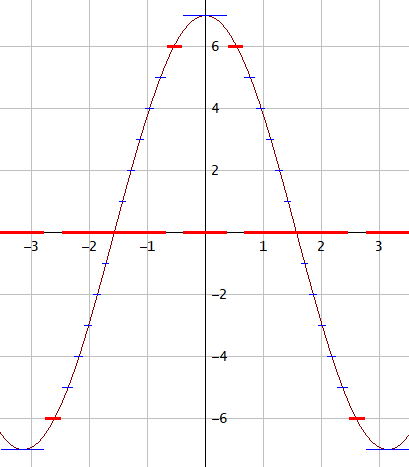In the limit $f/f_s \to 0,$ where $f$ is the sine wave frequency and $f_s$ is the sampling frequency, the answer to the question will be found in the Fourier series of the continuous-time piece-wise constant quantized waveform. We can construct the waveform as a sum of components like the red curve here illustrated for sine wave amplitude $N = 7$:
We are working with cosine instead of a sine because the math is nicer this way. Because of the symmetries, each component has only even harmonics and only cosine terms in its Fourier series. The non-zero coefficients of the Fourier series are given by:
$$a_n = \frac{4}{\pi}\int_{x_0}^{x_1}\cos(nx)\,k\,dx = \frac{4k}{\pi n}\big(\sin(x_1n) - \sin(x_0n)\big),\quad n\text{ odd},\tag{1}$$
with integer amplitude $k \in 1\ldots N$ in range $x_0 < x < x_1$ in the first quarter-period of the cosine. The Fourier series of the full piece-wise constant waveform is a sum of the Fourier series of the components. The boundaries of the pieces that we need to include in the sum are:
$$\begin{gather}0 < x < \operatorname{acos}\left(\frac{N - 0.5}{N}\right),\quad \text{if }k = N,\\ \operatorname{acos}\left(\frac{k + 0.5}{N}\right) < x < \operatorname{acos}\left(\frac{k - 0.5}{N}\right),\quad \text{if }k \in 0\ldots N-1.\end{gather}\tag{2}$$
The non-zero coefficients of the Fourier series of the full piece-wise constant waveform are then given by:
$$\begin{gather}a_n = \frac{4N}{\pi n}\sin\bigg(\operatorname{acos}\left(\tfrac{N - 0.5}{N}\right)n\bigg) +\\\frac{4}{\pi n}\sum_{k=1}^{N-1} \Bigg(k\sin\bigg(\operatorname{acos}\left(\tfrac{k - 0.5}{N}\right)n\bigg) - k\sin\bigg(\operatorname{acos}\left(\tfrac{k + 0.5}{N}\right)n\bigg)\Bigg),\quad n\text{ odd}.\end{gather}\tag{3}$$
It is not out of reach to compute Eq. 3 for $N=2^{23} - 1$ and $n \in {5, 7},$ as in the question, using something like the following in Python's mpmath. But let's try with a 16-bit sine wave first:
import mpmath as mp
def a_n(N, n):
return 4*N/(mp.pi*n)*mp.sin(mp.acos((N-0.5)/N)*n) + 4/(mp.pi*n)*mp.nsum(lambda k: k*( mp.sin(mp.acos((k-0.5)/N)*n) - mp.sin(mp.acos((k+0.5)/N)*n) ), [1, N-1])
N = 2**15-1 # amplitude (integer)
n = 5 # harmonic number (odd integer)
mp.mp.prec = 53 # default precision
20*mp.log10(mp.fabs(a_n(N, n))/N) # Fourier series term amplitude in dB
mp.mp.prec = 106 # Compute again with double the default precision, see if we get the same result
20*mp.log10(mp.fabs(a_n(N, n))/N) # Fourier series term amplitude in dB
mp.mp.prec = 53 # Restore default precision
I'm only reporting as many digits as agreed by repeated computation with two different precision settings: For a 16-bit full-scale sine wave the result is -154.66449 dB for the 5th harmonic and, after setting n = 7 in the script, -154.66506 dB for the 7th harmonic, in about 15 seconds of computation on my PC for a single result with the higher precision setting. As a sanity check, the amplitude of the 1st harmonic is, interestingly, 0.0000001605530 dB compared to the peak value. I think the rounding at the top of the sine wave may be "pulling it up", giving it a higher amplitude of the fundamental.
As a side note, what we have learned from the results already is that for such a high $N$ the amplitudes of the harmonics decay very slowly as function of harmonic number, so with rational $f/f_s,$ higher harmonics aliased to a lower harmonic are likely to be a majority contributor to the amplitude of the lower harmonic. As an example of such aliasing, with $f_s =$ 48 kHz and $f =$ 1000 Hz, the 5th harmonic gets added to by the 43th, 53th, 91th, 101th, 139th, 149th, etc. harmonic:
$$\begin{eqnarray} && \ldots\\ &=& 48000\text{ Hz}\times -3 + 1000\text{ Hz}\times149\\ &=& 48000\text{ Hz}\times -2 + 1000\text{ Hz}\times101\\ &=& 48000\text{ Hz}\times -1 + 1000\text{ Hz}\times53\\ &=& 1000\text{ Hz}\\ &=& 48000\text{ Hz}\times 1 - 1000\text{ Hz}\times43\\ &=& 48000\text{ Hz}\times 2 - 1000\text{ Hz}\times91\\ &=& 48000\text{ Hz}\times 3 - 1000\text{ Hz}\times139\\ &=& \ldots\end{eqnarray}\tag{4}$$
The effect of the addition of the aliases depends on the phase of the sinusoid.
My calculations concern the limit $f/f_s \to 0$ in which case there is no aliasing. I will try to compute overnight your desired numbers for $N=2^{23} - 1$ in high precision, in the limiting case $f/f_s \to 0$, using the following:
N = 2**23-1 # amplitude (integer)
n = 5 # harmonic number (odd integer)
mp.mp.prec = 70 # Precision 1
20*mp.log10(mp.fabs(a_n(N, n))/N) # in dB
mp.mp.prec = 140 # Precision 2
20*mp.log10(mp.fabs(a_n(N, n))/N) # in dB
n = 7 # harmonic number (odd integer)
mp.mp.prec = 70 # Precision 1
20*mp.log10(mp.fabs(a_n(N, n))/N) # in dB
mp.mp.prec = 140 # Precision 2
20*mp.log10(mp.fabs(a_n(N, n))/N) # in dB
mp.mp.prec = 53 # Restore default precision
Let's see what I have in the morning....

